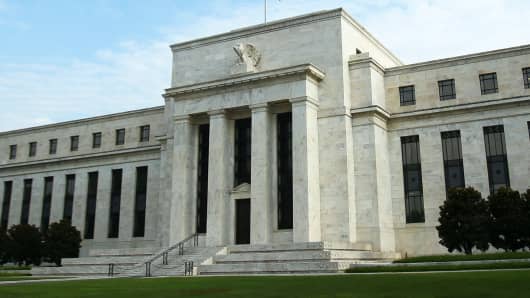Warsh and Druckenmiller argue that the Fed's policies of pushing down interest rates and raising asset prices have created balance-sheet wealth but not real economic growth. "Meanwhile, corporate chieftains rationally choose financial engineering—debt-financed share buybacks, for example—over capital investment in property, plants and equipment."
But a look at the connection between stock prices, quantitative easing and investment raises questions about their cause-and-effect argument.
Read MoreStop expecting the Fed to surprise you: Ron Insana
Long before the Fed eased policy or began quantitative easing, real private fixed investment in the United States was in the dumps, falling at 3-percent annual rate in the two years before the Fed increased its balance sheet by a single dollar. Over those eight quarters, only a single one was positive. In Aug. 2007, more than a year into the decline, the Fed began cutting rates. It is simply impossible to look at the data and see Fed policy causing business investment to scale back.
In the third quarter of 2008, the declines accelerated into double digits. It was only several months later that the central bank lowered its interest rates to zero and began purchasing assets. By the end of 2009, after the Fed has purchased $1.3 trillion in assets, business investment surged 36 percent and would enjoy four quarters of growth. Some of the ups and downs are clearly related to on-again, off-again tax incentives. But it clearly raises questions about the Warsh and Druckenmiller idea that Fed policy caused business investment to decline.
Read MoreFed policies are 'a catastrophe': Marc Faber
In 2010, once again, business investment declined and the Fed launched into another round of bond purchases, followed by a recovery, although less robust than the first recovery. And QE3, was launched in September 2012, followed by a rebound in business investment. The pattern is simple: QE has followed by or coincident with declines in investment, not leading.
Finally, Warsh and Druckenmiller must be aware of the long connection between rising stock prices and investment, which has actually been borne out this year. While the Fed has been pumping money into the economy, there have been 134 initial public offerings this year, up 63 percent from the same period a year ago. That follows 2013, which was the strongest full year by a decade. Is not the IPO market the capitalist cradle of job creation and investment?
There is a nearly 90 percent correlation between the S&P 500 and business investment as measured in shipments of non-defense capital goods, excluding aircraft, a monthly proxy for business investment. That is to say, when investment goes up, asset prices go up about 90 percent of the time. And their growth rates are correlated 60 percent of the time. This makes sense. Rising stock prices should make investment more profitable.
These are two exceedingly smart men and it is possible that Warsh and Druckenmiller have a causal agent in mind that they simply fail to detail or believe the case is so self-evident that it needs no explanation. It may be they have data they simply fail to present.



